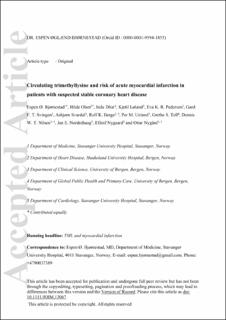| dc.contributor.author | Bjørnestad, Espen Ø. | |
| dc.contributor.author | Olset, Hilde | |
| dc.contributor.author | Dhar, Indu | |
| dc.contributor.author | Løland, Kjetil Halvorsen | |
| dc.contributor.author | Pedersen, Eva Ringdal | |
| dc.contributor.author | Svingen, Gard Frodahl Tveitevåg | |
| dc.contributor.author | Svardal, Asbjørn M. | |
| dc.contributor.author | Berge, Rolf K | |
| dc.contributor.author | Ueland, Per Magne | |
| dc.contributor.author | Tell, Grethe S. | |
| dc.contributor.author | Nilsen, Dennis W.T. | |
| dc.contributor.author | Jan E., Nordrehaug | |
| dc.contributor.author | Nygaard, Ellisif | |
| dc.contributor.author | Nygård, Ottar | |
| dc.date.accessioned | 2021-06-01T09:22:57Z | |
| dc.date.available | 2021-06-01T09:22:57Z | |
| dc.date.created | 2020-12-21T15:41:13Z | |
| dc.date.issued | 2020 | |
| dc.identifier.issn | 0954-6820 | |
| dc.identifier.uri | https://hdl.handle.net/11250/2757175 | |
| dc.description.abstract | Background
The carnitine precursor trimethyllysine (TML) is associated with progression of atherosclerosis, possibly through a relationship with trimethylamine-N-oxide (TMAO). Riboflavin is a cofactor in TMAO synthesis. We examined prospective relationships of circulating TML and TMAO with acute myocardial infarction (AMI) and potential effect modifications by riboflavin status.
Methods
By Cox modelling, risk associations were examined amongst 4098 patients (71.8% men) with suspected stable angina pectoris. Subgroup analyses were performed according to median plasma riboflavin.
Results
During a median follow-up of 4.9 years, 336 (8.2%) patients experienced an AMI. The age- and sex-adjusted hazard ratio (HR) (95% CI) comparing the 4th vs. 1st TML quartile was 2.19 (1.56–3.09). Multivariable adjustment for traditional cardiovascular risk factors and indices of renal function only slightly attenuated the risk estimates [HR (95% CI) 1.79 (1.23–2.59)], which were particularly strong amongst patients with riboflavin levels above the median (Pint = 0.035). Plasma TML and TMAO were strongly correlated (rs = 0.41; P < 0.001); however, plasma TMAO was not associated with AMI risk in adjusted analyses [HR (95% CI) 0.81 (0.58–1.14)]. No interaction between TML and TMAO was observed.
Conclusion
Amongst patients with suspected stable angina pectoris, plasma TML, but not TMAO, independently predicted risk of AMI. Our results motivate further research on metabolic processes determining TML levels and their potential associations with cardiovascular disease. We did not adjust for multiple comparisons, and the subgroup analyses should be interpreted with caution. | en_US |
| dc.language.iso | eng | en_US |
| dc.publisher | Wiley | en_US |
| dc.title | Circulating trimethyllysine and risk of acute myocardial infarction in patients with suspected stable coronary heart disease | en_US |
| dc.type | Journal article | en_US |
| dc.type | Peer reviewed | en_US |
| dc.description.version | acceptedVersion | en_US |
| dc.rights.holder | Copyright 2020 The Association for the Publication of the Journal of Internal Medicine | en_US |
| cristin.ispublished | true | |
| cristin.fulltext | postprint | |
| cristin.qualitycode | 2 | |
| dc.identifier.doi | 10.1111/joim.13067 | |
| dc.identifier.cristin | 1862438 | |
| dc.source.journal | Journal of Internal Medicine | en_US |
| dc.source.pagenumber | 446-456 | en_US |
| dc.identifier.citation | Journal of Internal Medicine. 2020, 288(4), 446-456 | en_US |
| dc.source.volume | 288 | en_US |
| dc.source.issue | 4 | en_US |
